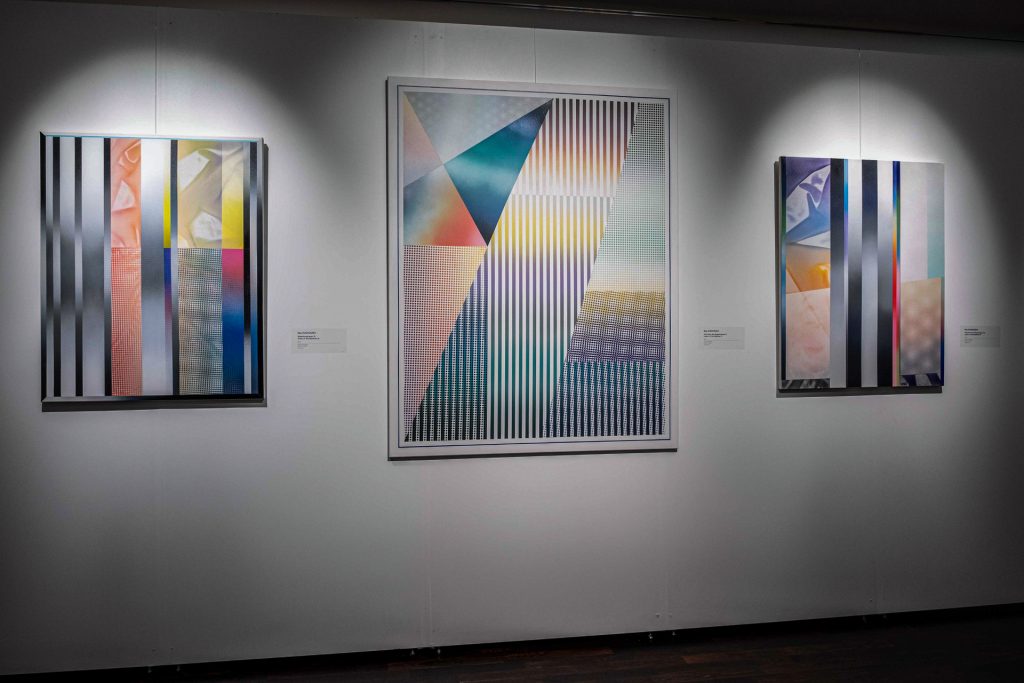The next exhibition of the contemporary art collection of the Central Bank of Hungary: “Code + Canvas” in the Collegium Hungaricum Berlin
The exhibition organised by MNB Arts and Culture titled “Code + Canvas. Post-digital works from the collection of the Central Bank of Hungary” is opening on 9 February, 2024 at the Collegium Hungaricum Berlin (CHB)
The exhibition brought to life by a collaboration between MNB Arts and Culture and Collegium Hungaricum Berlin, presents a selection of contemporary artworks from the collection of the Central Bank of Hungary (Magyar Nemzeti Bank – MNB), along the concept of the curators Kinga Hamvai and Zsuzska Petró.
The show, which opens on 9 February, can be seen until 22 March in the exhibition space of the Collegium Hungaricum Berlin, Dorotheenstraße.
Exhibited artists: Róbert Batykó, Martin Góth, Judit Horváth Lóczi, Bea Kusovszky, Márton Nemes, Tomasz Piars, Gergő Szinyova, Ádám Varga and Orsolya Lia Vető.
Code + Canvas: The window to the digital soul
The material containing works by emerging artists of Generation Y, focuses on one of the most influential artistic trends of recent years, the post-digital movement.
The members of this generation, also known as digital natives, a term popularised by Marc Prensky, are the ones who have literally been born into the world of computers, the internet and social media, which has not only changed their social relationships but also their perception of reality. In addition to the material world, the digital medium and the world of the internet have become their community space and natural visual environment, and as artists they are also inevitably inspired by this. For them, the digital world is not just a medium, it is one of their living spaces.
„Code + Canvas” offers an insight into the perception of reality and artistic practices of Generation Y, as well as a look at one of the most important art movements of recent years.
From bits to brushstrokes: Art of the post-digital age
The post-digital art movement allows artists to move freely between physical and digital space. Online reproductions of analogue artefacts are often disconnected not only from their spatiality, but also from their cultural and historical context. The resulting visual signals can be used and rearranged without any hierarchy or framework, and the digital reproduction of the artwork is therefore now just as important as the tangible object itself. The works of art, created with craftsmanship, requiring precision workmanship and lengthy experimentation, exist in this virtual framework as much as a work created with the digital tools. The artist-users „download” and create their visual language from this heterogeneous, chaotically swirling cloud as a reference network.
The artists featured in the exhibition employ different strategies to create a balance between the digital and analogue world. Some design their work using digital technology, in whole or in part, and then combine it with traditional imaging techniques. Others explore printing techniques, the reproducibility of images, the original and the copy, and the complex relationship between man and machine.
The nine artists on show not only offer an insight into the technological developments and challenges of the post-digital era, but also offer a diverse range of forms of expression. From the performative gestures of abstract expressionism to the diary-like representation of personal stories and biographical elements, all artistic practices contribute to the diversity and complexity of this emerging artistic movement.
A century at the interface of culture and science
The exhibition is presented by the Collegium Hungaricum Berlin (CHB), which has hosted cultural and scientific exchanges between Hungary and Germany since 1924. The year 2024 also marks the 100th anniversary of the founding of both the Collegium Hungaricum Berlin and the Central Bank of Hungary.
Dr Márta Nagy, Head of the Institute, said: „The jubilee exhibition at CHB is a tribute to the institution’s enduring role as a catalyst for cultural exchange and innovation. For a hundred years, the CHB has been a constant arena for groundbreaking artistic and scientific dialogue.”
Dr. Kinga Hamvai, Head of MNB Arts and Culture and curator of the exhibition, stressed that: „Since the beginning of establishing the collection, the MNB has made it a priority to make the artworks in the collection visible to the general public, which we consider and treat as part of our national heritage. The Central Bank of Hungary, 100 years old this year, is proud of its patronage of the arts and its role in linking culture and the economy. We are particularly pleased with the coincidence of two centenary institutions have collaborated in the creation of this exhibition.”
In addition to the striking presence of post-digital visual culture (the aesthetics of flickering screens, perfect colour gradients, glitches), the exhibiting artists are all intrinsically linked to the traditions of art and painting.
Exhibition venue: Collegium Hungaricum Berlin, Dorotheenstraße 12, 10117 Berlin
On view: between 9 February and 22 March 2024
Further information:
MNB Arts and Culture:
MNB Arts & Culture manages the contemporary art collection of the Central Bank of Hungary and one of its main objectives is to give it international visibility. The works are also made available digitally, and priority is given to presenting the material of the collection in thematic exhibitions from time to time, in Hungary and abroad. The exhibition titled „The Journey – János Fajó and the Pesti Műhely”, organised in collaboration with the Fajó Foundation, is currently at its seventh location in China.
The exhibition catalog is available HERE.
The MNB aims to make the collection accessible to the general public, and therefore, in parallel with its own exhibitions, it also offers a wider range of loans of artefacts.
↖ Batykó Róbert: Clickbait, oil, canvas, 2019, 112×85,5 cm















